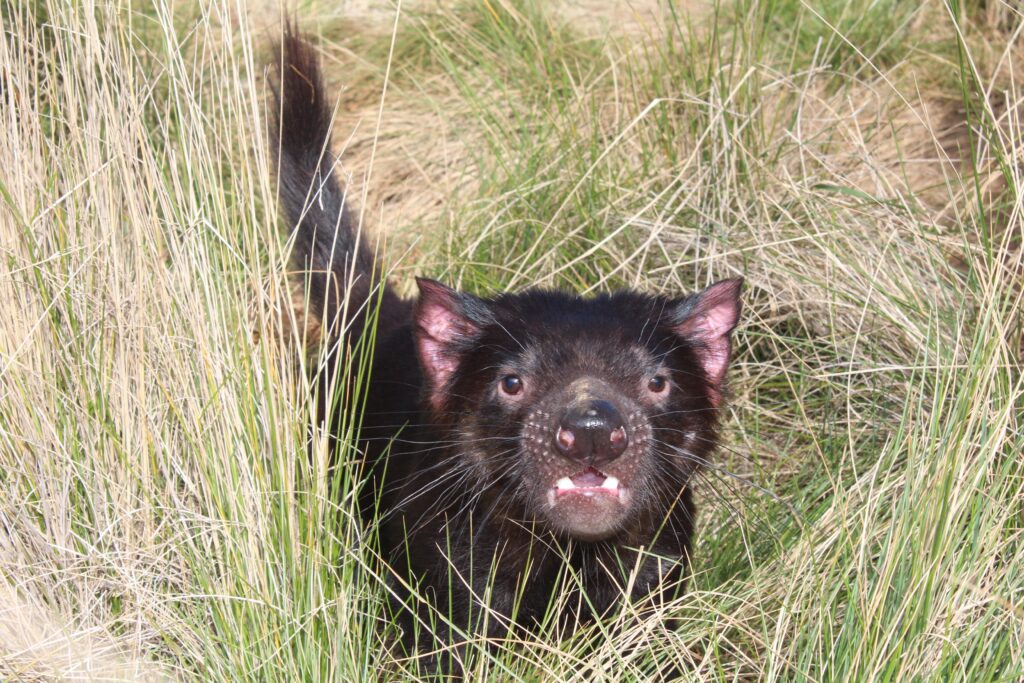by Joe Eaton
(Full article from RATS Tales March 2025)
Thanks to those Warner Brothers cartoons, the Tasmanian devil is an international celebrity. (The irascible and inarticulate Taz made his debut 70 years ago in Devil May Hare, opposite Bugs Bunny.) But few non-Australians have ever heard of a quoll. Devils and the four Australian quoll species have several things in common. Assuming the thylacine (aka the Tasmanian tiger or wolf) is really extinct, they’re the island continent’s largest surviving marsupial carnivores, antipodean counterparts of cats, foxes, weasels, and badgers. They’re all listed as threatened—victims of habitat loss, predation by introduced species, and, in the case of the Tasmanian devil, a transmissible form of cancer known as devil facial tumor disease (DFTD). And they’re the latest Australian animals found to be victims of anticoagulant rodenticide (AR) poisoning.

In a recent article in Science of the Total Environment, Michael Lohr of Edith Cowan University and his co-authors report that half of 52 Tasmanian devils and quolls tested positive for at least one AR, and that AR poisoning may have killed up to 17 percent of the sampled animals. The authors also raise the possibility that AR exposure may make devils more susceptible to the devastating tumor disease.
Now confined to their namesake island, Tasmanian devils once occurred in the rest of the country; they’re depicted in ancient indigenous rock art in Kakadu National Park in the Northern Territory. The mainland population succumbed to predation by and competition with dingoes, descendants of domestic dogs that arrived with human settlers about 3000 years ago.
Tasmania also became a last refuge for the formerly more widespread eastern quoll. The other three quolls—the spotted-tailed and northern quolls and the chuditch, also known as the western quoll—occupy fragmented ranges around the country’s periphery. (Two additional quoll species in New Guinea were not included in the study.) In addition to other stressors, devil and quoll numbers have been reduced by outbreaks of distemper-like disease.
Most of the animals in the study were found dead and turned over to the scientists by volunteers; others came from museums and a government agency. One chuditch was found alive in the backyard of a home in an exurban area of Western Australia and subsequently died at a rehabilitation center.
The first generation ARs (FGARs) pindone (used on rabbits) and warfarin, as well as the second generation ARs (SGARS) brodifacoum, bromadiolone, and difenacoum, were found in the liver tissue of the quolls and devils. Brodifacoum was the most prevalent (21 individuals), followed by bromadiolone (10). The back yard chuditch had been exposed to brodifacoum, difenacoum, and warfarin and had the highest AR levels in the sample: 1.7 milligrams per kilogram. One of the Tasmanian devils tested positive for pindone, brodifacoum, and bromadiolone. Nine other animals had residues of two ARs.
Rodenticide poisoning was confirmed as the cause of death for one of the two necropsied subjects, and 17 percent had consumed potentially lethal, likely lethal, or lethal quantities of rodenticide. Northern quolls from the remote Pilbara region of Western Australia had very low exposure levels. Otherwise, landscape variables were not reported.

Rodents, both exotics and non-target native species, are a likely pathway for AR exposure in devils and quolls. Voracious predators, quolls feed on rodents and other small mammals, as well as insects, frogs, lizards, and birds. The housecat-sized spotted-tailed quoll is capable of killing wallabies, and the smaller chuditch takes prey up to the size of a rabbit. The diet of Tasmanian devils includes wombats, wallabies, and possums.
Quolls will also scavenge possum carcasses, and plant-eating possums are known to consume rodenticide bait. (In a recent study by Kieran Scammell of Deakin University and colleagues, SGARs were found in the livers of 91 percent of brushtail possums and 40 percent of ringtail possums sampled in the state of Victoria. Possums are also a major prey item for the powerful owl, listed as vulnerable in Victoria and New South Wales.)
“Three of the devils were noted to have DFTD,” co-author Robert Davis said in an email. It appears that none of the 20 devils sampled were from the few remaining DFTD-free populations. So far, there’s no data supporting a causal relationship between the disease, first reported in 1996, and AR exposure. However, the authors note that ARs have been shown to cause immune system dysfunction in bobcats. Their recommendation: “Since ARs may exacerbate the effects of DFTD, there is an urgent need for research investigating whether AR exposure impacts immune function in Tasmanian Devils and whether there are meaningful interactions between sublethal AR exposure and the progression of DFTD.”
Sublethal effects aside, direct AR-related mortality is an obvious threat to these at-risk species. The new study adds to the roster of Australian wildlife impacted by ARs, which already included eagles, owls, possums, snakes, lizards, frogs, and even one species of parrot, the Carnaby’s black cockatoo. “The more we look, the more we find,” Davis commented last year. Meanwhile, AR use remains unregulated, and the responsible government agency, the Australian Pesticides and Veterinary Medicines Authority, continues to delay action. A review of SGAR registration began in 2016, but a final decision is not expected until 2026 at the earliest.
